Oviatt Building
1928 – Albert Walker and Percy Eisen
617 South Olive Street – map
Declared: 7/19/78
“THE DOORS of the new Oviatt Building are open – the magnificent new store of Alexander & Oviatt is ready for you – the incomparable Oviatt styles are now given a setting of unprecedented elegance. The whole of this towering building owes its conception to the richness of Alexander & Oviatt merchandise – merchandise that deserved a setting worthy of it. So the building was planned to provide the store – and the store was designed to properly show the merchandise.”That’s from the opening day announcement on May 15, 1928, of the James Oviatt Building, the new headquarters of Los Angeles’s premiere luxury clothing store, Alexander & Oviatt.
Oviatt excavation.
Born in 1888, James Oviatt arrived in L.A. from Utah in 1907, getting a job as a haberdasher in Desmond’s department store downtown. In 1912, he, along with partner Frank Alexander (the “money man”), opened their new store, Alexander & Oviatt, at 609 West Fourth Street. Quickly building a high-end clientele, A&O relocated to Sixth and Hill in 1914, later expanding twice.
The vintage shots are from the CA State Library.
Plans for the new, twelve-story structure behind the Sixth and Hill shop were announced as early as January 1923. Architects Albert Walker and Percy Eisen were already working on designs for a new building when Oviatt, on a 1925 European trip, became inspired by Paris’s Exposition Internationale des Arts Decoratifs et Industriels Modernes. He knew the direction he wanted his building to take.
The Oviatt Building was loaded with the work of famed French glassmaker Rene Lalique, who designed and built the entrance doors, the elevator doors for both the store and the building, and art glass windows throughout the building. While larger entrance doors sported a pair of bell-ringing angels representing Los Angeles, smaller doors feature the Alexander & Oviatt crest. The smaller doors with the crests remain (below), but the larger “Angel” doors are now in the Utah Museum of Fine Arts.
Lalique was also responsible for the metalwork for the elevator doors, the mailboxes, and directories.
Interiors were designed by Joseph Feil of Feil & Paradise. Fiel and Oviatt also collaborated with artist Gaëtan Jeannin on one of the building’s two most famous features – the entrance arcade’s ceiling. Made up of thirty-two tons of etched glass panels, that original ceiling was eventually sold off for fifty dollars and removed. See much of the original glass at this website. However, a small handful of original Jeannin panels, like this one, remain at the building:
The other of the landmark’s most-famous components remains – Oviatt’s ten-room penthouse. Decorated by Parisian cabinetmakers Saddier et Fils, the penthouse, full of of burled maplewood and mahogany and theya wood, burgundy silk and gold satin, is considered L.A.’s first Art Deco residence. There’s lots of Lalique, too. But you don’t need me to tell you about the penthouse. Just watch and listen to Delilah Anderson (even though she’s clearly talking to me, personally) tour the bedroom, bathroom, bar, and more.
The penthouse opens to a pair of terraces. Back in the day, the lower terrace held a swimming pool, tennis court, and a putting green. For the upper, Oviatt imported sand from the French Riviera for his own rooftop beach. The roof also sports that landmark neon clock, with its trio of faces, thirteen feet in diameter. Imported from France, the clock played “Chimes of Normandy” along with “several other old-world melodies, as well as national airs and Christmas carols.”
When it opened in the spring of 1928, the building’s lower three floors were dedicated to the haberdashery of Alexander & Oviatt (though Frank Alexander died in 1921, Oviatt, for a dozen years, continued using the full name): the first floor held “furnishings, hats, golf hose, sweaters and custom shirts”; the mezzanine was devoted in part to the Salon des Elegances, the women’s department; on the second floor, along with “luggage, leather goods, traveling accessories, riding clothes, and shoes”, the Outdoor California Palm Grove gave shoppers the opportunity to inspect Oviatt clothing in “natural daylight”; the third floor held the company’s offices and workrooms.
The interior is Art Deco, but the exterior is Romanesque.
Oviatt’s clothing store closed its doors in February, 1967. Two years after Oviatt’s death in 1973 (even anti-Semite John Birch members die, by the way), the ownership of the Oviatt Building somehow transferred to the Roman Catholic Archdiocese of L.A. In 1977, a group, headed by developers Wayne Ratkovich and Don Bowers, calling itself Oviatt Associates, bought the 87,000-square-foot building for $400,000 and kicked off what would amount to a $5 million restoration. Jean Clyde Mason directed the restoration of the penthouse. Restaurateur Mauro Vincenti leased out the ground floor for Rex il Ristorante and the ubiquitous Brenda Levin was hired for the restaurant’s renovation (you can see it in Pretty Woman).
The gate is great, but not original. It was designed by Jean Clyde Mason as part of the 1970s restoration.
The Oviatt Building was listed on the National Register of Historic Places in 1983. A year later, Ratkovich sold the Oviatt Building to a Japanese company for $13.5 million.
The renovated arcade.
Today, the Oviatt Building is owned by Blue Real Estate Management, and Cicada has been the restaurant since 1997. Here are three films you should watch – the Hollywood Hotshot Dancers, Rusty Frank & Chester Whitmore, and Dean Mora’s Modern Rhythmists, all part of Maxwell DeMille’s Cicada Club.
It’s painfully obvious I didn’t get inside the Oviatt Building. Since the interior, especially the penthouse, is what the landmark’s all about, I don’t know if I can even justify having visited the Oviatt. Now, like Delilah said, you can rent the penthouse for private parties and wedding receptions and such. Or, you can try what I did – take the L.A. Conservancy’s Art Deco Walking Tour, as the penthouse is part of the tour, subject to availability. But while I extremely recommend it, on the recent Saturday I took the tour, the penthouse was being prepped for a wedding reception, preventing our group’s access.
It’s painfully obvious I didn’t get inside the Oviatt Building. Since the interior, especially the penthouse, is what the landmark’s all about, I don’t know if I can even justify having visited the Oviatt. Now, like Delilah said, you can rent the penthouse for private parties and wedding receptions and such. Or, you can try what I did – take the L.A. Conservancy’s Art Deco Walking Tour, as the penthouse is part of the tour, subject to availability. But while I extremely recommend it, on the recent Saturday I took the tour, the penthouse was being prepped for a wedding reception, preventing our group’s access.
"The Oviatt Building"
Finally, if you’re interested in the history of the Oviatt Building, I can’t recommend highly enough your buying a DVD of Puzzled Pictures’ brand new documentary, The Oviatt Building. Directed by Seth Shulman and produced by Marc Chevalier, The Oviatt Building gives you the whole history – and then some – of the eighty-year-old building. Order your copy from the Puzzled Pictures website, and view the trailer right above. Thanks, guys, for the great work.
Sources:
“Addition to Busy Section” The Los Angeles Times; Jan 21, 1923, p. V2
“New Store is Opened to the Public” The Los Angeles Times; May 4, 1923, p. I12
“New Store Building to Start Soon” The Los Angeles Times; Mar 12, 1927, p. A6
“Genius Honors Local Builder” The Los Angeles Times; Dec 4, 1927, p. B9
“The New Store of Alexander & Oviatt Opens Today!” The Los Angeles Times; May 15, 1928, p. 9
Gray, Olive “Alexander and Oviatt Goal Won.” The Los Angeles Times; Aug 12, 1931, p. A7
Turpin, Dick “Oviatt Building Ready to Make a Comeback” The Los Angeles Times, Feb 27, 1977, p. J1
Kinchen, David M. “Restaurant Planned for Oviatt” The Los Angeles Times; Apr 8, 1979, p. H1
McMillian, Elizabeth Deco & Streamline Architecture in L.A. Schiffer Publishing Ltd 2004 Atglen, PA
Up next: Variety Arts Center Building
“Addition to Busy Section” The Los Angeles Times; Jan 21, 1923, p. V2
“New Store is Opened to the Public” The Los Angeles Times; May 4, 1923, p. I12
“New Store Building to Start Soon” The Los Angeles Times; Mar 12, 1927, p. A6
“Genius Honors Local Builder” The Los Angeles Times; Dec 4, 1927, p. B9
“The New Store of Alexander & Oviatt Opens Today!” The Los Angeles Times; May 15, 1928, p. 9
Gray, Olive “Alexander and Oviatt Goal Won.” The Los Angeles Times; Aug 12, 1931, p. A7
Turpin, Dick “Oviatt Building Ready to Make a Comeback” The Los Angeles Times, Feb 27, 1977, p. J1
Kinchen, David M. “Restaurant Planned for Oviatt” The Los Angeles Times; Apr 8, 1979, p. H1
McMillian, Elizabeth Deco & Streamline Architecture in L.A. Schiffer Publishing Ltd 2004 Atglen, PA
Up next: Variety Arts Center Building

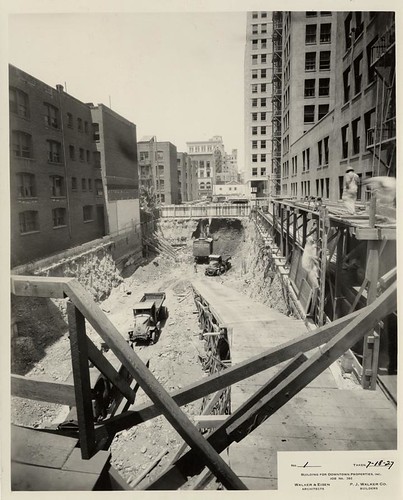

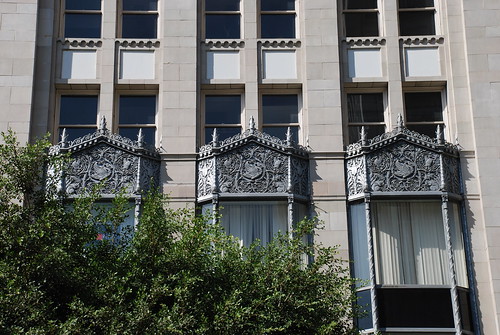
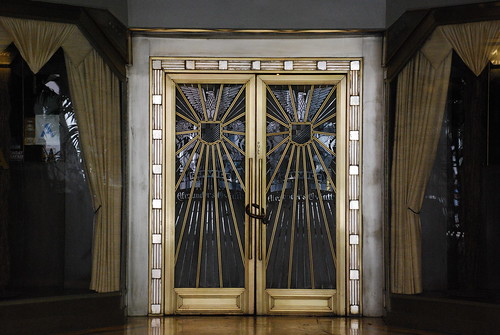
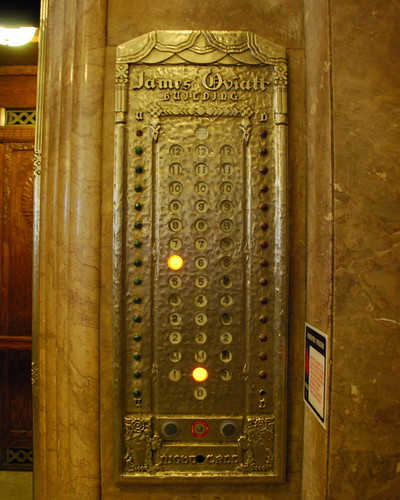
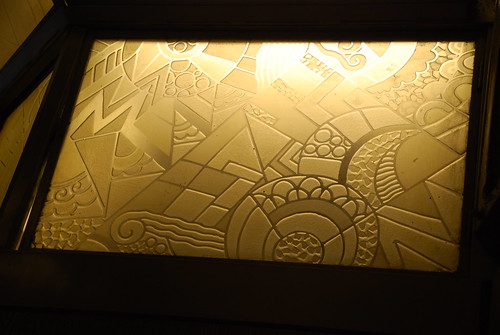

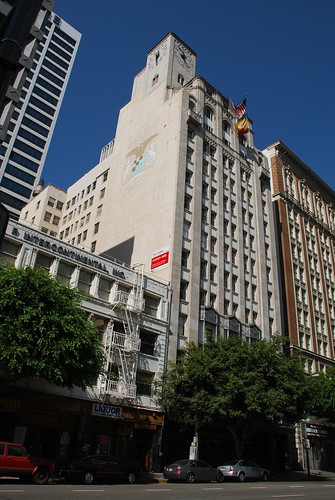
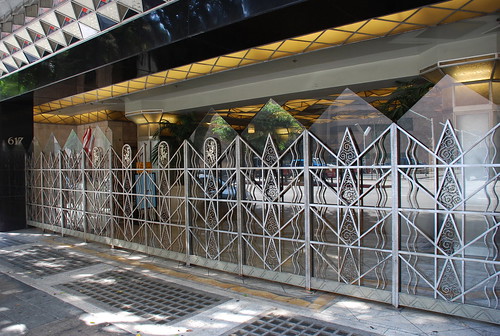
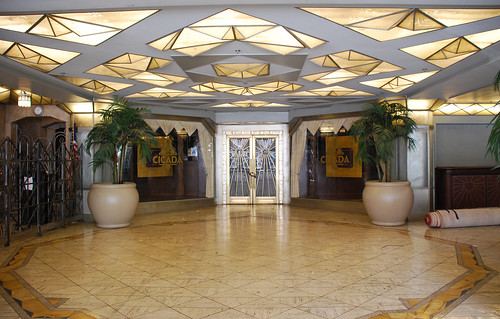
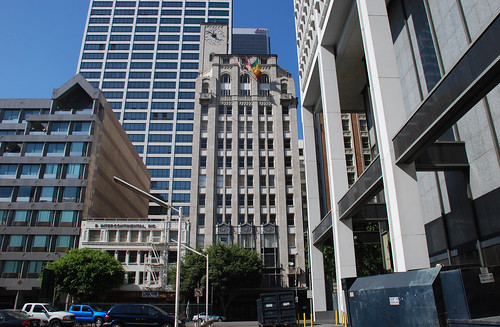

14 comments:
Great post! I'm going to have to get that dvd now.
Yeah, it's good for the history of not just the Oviatt, but for downtown L.A. in general.
Hello Floyd -- This is truly a jewel in the Art Deco crown. I’ve had cocktails there with the Art Deco Society, but never really knew what that building housed, or about the clothing store connection. Now I know there is a restaurant and a penthouse, but still don’t know what this building is all about. Is it a hotel, or an office building, or are there still shops there, or is it multi-use, or what? I don’t mean for you, Floyd, to answer that question, but next time I’m there I’ll explore it more thoroughly. Another Deco treasure lost was the Richfield building which was demolished to build the ARCO Plaza. I wish they had built all that stuff, “the Towers,” the Bonaventure Hotel, the World Trade Center, etc. one block further north and saved that block with the Richfield Building. But L.A. was on a steamroller of development in those days, and the-powers-that-be could care less about "preservation." Thankfully the mind set and attitudes have changed. -- Robert
Hi, Robert. The Richfield Building is certainly in my list of L.A. buildings I wish were still around. I'm glad you got the opportunity to see it in person.
I'm an Art Deco docent for the LA Conservancy and, confirming what Floyd said, we're able to access the Oviatt's penthouse about 80-90% of the time during our tours. Sometimes we have access to the restaurant, as well, but rarely do we get into both. It's all a matter of whether they're setting up for private functions or not.
As we understand it, floors 1-3 were devoted to the store and offices, the top 2 were the penthouse (the floor below the living quarters contained the main kitchen, guest bedrooms and baths and, I would assume, maid quarters). The middle floors were...and remain, offices - with much of the original glass and woodwork intact. The large, 2nd-story windows facing Olive Street enabled customers to "model" their clothing in natural daylight.
Needless to say, it's a highlight of the tour (although the interior of the So. California Edison Building (One Bunker Hill) is a huge favorite, too!
Thanks, Bruce. Of course, I encourage everyone to take the Conservancy's walking tour - just $5 for members. Ridiculously cheap.
Attended an elegant rooftop wedding ceremony and reception here. Quite a view.
Floyd--What became of the ceiling of the Oviatt entrance? I understand that it was dismantled by two men who divided it. One half supposedly was going to be used in a restaurant that was never built. But, it seems to have disappeared like the Amber Room did from Catherine's Palace in St. Petersburg.
Hi, hipeeps. You're not wrong about the ceiling being split up. You should really get a copy of Seth Shulman and Marc Chevalier's documentary, The Oviatt Building. It'll give you the answers to your questions (and more).
HI Floyd. Great information about the Oviatt. I wanted to commend our website about Rene Lalique to you. We did an Oviatt Building article in our blog early in the year, with a little history but mainly pointing out the Rene Lalique connection, so nowhere near as informative or detailed as your article. Though we did uncover the TV Bride video! Anyway, the site is Rene Lalique at RLalique.com, and Rene Lalique-Oviatt will take you straight to the Oviatt Building article. And again, great blog and we also are going to have to get the DVD. Oh, if you do write-ups on any other buildings that have a Rene Lalique connection, please keep in mind to let us know and we can link to the articles.
"As we understand it, floors 1-3 were devoted to the store and offices, the top 2 were the penthouse (the floor below the living quarters contained the main kitchen, guest bedrooms and baths and, I would assume, maid quarters)....The large, 2nd-story windows facing Olive Street enabled customers to "model" their clothing in natural daylight."
Yes and no. It's true that the basement and floors 1-3 were devoted to the store and its workrooms/offices. However, the 12th floor was never really part of the penthouse: it housed the building's administrative office, several other offices, and a kitchen. The only "guest bedroom" on the 12th floor was a tiny room next to the kitchen: Jimmy Oviatt, James Oviatt's son, slept there, as there weren't enough bedrooms in the penthouse above to house him.
The large 2nd-story windows facing Olive St. weren't used to model the clothes in natural daylight. Instead, the clothes were taken to a long, rectangular outdoor patio on the back left side of the building's 3rd floor. The patio is still there, but few people get to see it.
-- Marc Chevalier, producer of "The Oviatt Building" documentary DVD
Thats sad you couldnt get in. As a kid i used to roam all over these place like the oviatt and the alexandria noone cared you just walked in and went up and walked around. The penthouse is cool. I always thought the arcade cieling was wierd were is it now I wonder. Alots missing from LA. I no longer feel the 1920s here anymore. The smell of jasmine the crickets and the old landscaping are gone. All that 1920s landscaping left untouched all those years gave old LA such a haunting feel what they did to echo park and MacArthur park is disgusting they were so authentic growing up and romantic.
I met Mark Chevalier over the weekend in the Oviatt, a wonderfully nice, very informative man. It was my pleasure. For anyone who comes across this, the Oviatt penthouse is not currently being run by the conservancy but by a private company called Truly Yours Catering. You may be able to arrange a tour by contacting them.
The link to decoglassceiling.com is not working. Do you have info to a new link or another site where images of the original interior glass can be viewed?
Post a Comment